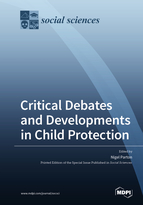Critical Debates and Developments in Child Protection
A special issue of Social Sciences (ISSN 2076-0760). This special issue belongs to the section "Childhood and Youth Studies".
Deadline for manuscript submissions: closed (1 March 2020) | Viewed by 85495
Special Issue Editor
Interests: social problems and social welfare; child protection and child welfare; social work; social policy
Special Issues, Collections and Topics in MDPI journals
Special Issue Information
Dear colleagues,
The last 50 years have witnessed increasing public, political, and media concern about the problem of child maltreatment and what to do about it. This is now evident in most jurisdictions and is receiving serious attention from many international and transnational organizations. While the (re)discovery of the problem in the USA in the 1960s was particularly associated with the ‘battered baby syndrome’, this concern has now expanded to include physical abuse, sexual abuse, neglect, emotional abuse, abuse on the internet, child trafficking, sexual exploitation, female genital mutilation, and radicalization and is now seen to effect all children and young people, not just young babies. Similarly, the focus of attention has broadened from intra-familial abuse to abuse in a whole variety of settings, including schools, day care, the church, and the wider community. There has also been a broadening of concern over not only protecting children and young people from serious harm, but also preventing the impairment of their health and development and ensuring that they are able to grow up in circumstances that are consistent with the provision of safe and effective care so that all children can achieve the best outcomes.
In the process, the laws, policies, practices, and systems to identify and prevent child maltreatment, have become much more wide-ranging and complex and have themselves been subject to continual review. Social workers, health and education workers, the police, and other criminal justice workers, as well as members of the wider community are all seen to have key roles to play in both protecting children and young people and assessing and monitoring actual and potential perpetrators.
Increasingly, the efficacy and effectiveness of child protection policies, practices, and systems have been subject to high-profile media and political scrutiny and have been the subject of critical social science analysis. The purpose of this Special Issue is to provide a platform for such critical debates, encouraging analysis of child protection policies and practices and presenting recommendations for how they might be improved. It builds on a previous Special Issue in Social Sciences in 2014—‘Contemporary Developments in Child Protection’. This Special Issue encourages the submission of papers from a wide range of disciplines, including law, sociology, politics, criminology, psychology, anthropology, education, health, social work, social policy, and gender studies, as well as contributions that are cross-disciplinary and inter-disciplinary.
Prof. Dr. Nigel Parton
Guest Editor
Manuscript Submission Information
Manuscripts should be submitted online at www.mdpi.com by registering and logging in to this website. Once you are registered, click here to go to the submission form. Manuscripts can be submitted until the deadline. All submissions that pass pre-check are peer-reviewed. Accepted papers will be published continuously in the journal (as soon as accepted) and will be listed together on the special issue website. Research articles, review articles as well as short communications are invited. For planned papers, a title and short abstract (about 100 words) can be sent to the Editorial Office for announcement on this website.
Submitted manuscripts should not have been published previously, nor be under consideration for publication elsewhere (except conference proceedings papers). All manuscripts are thoroughly refereed through a double-blind peer-review process. A guide for authors and other relevant information for submission of manuscripts is available on the Instructions for Authors page. Social Sciences is an international peer-reviewed open access monthly journal published by MDPI.
Please visit the Instructions for Authors page before submitting a manuscript. The Article Processing Charge (APC) for publication in this open access journal is 1800 CHF (Swiss Francs). Submitted papers should be well formatted and use good English. Authors may use MDPI's English editing service prior to publication or during author revisions.
Keywords
- Child abuse
- Child protection
- Child maltreatment
- Public protection
- The role of state, family, and community
- Family support
- Social surveillance
- Risk to children






